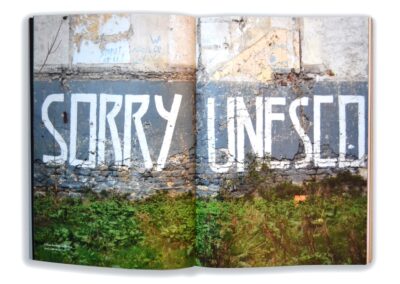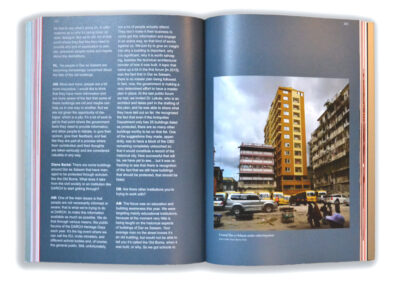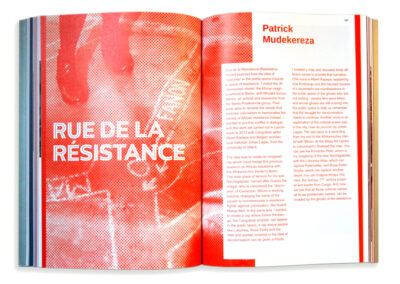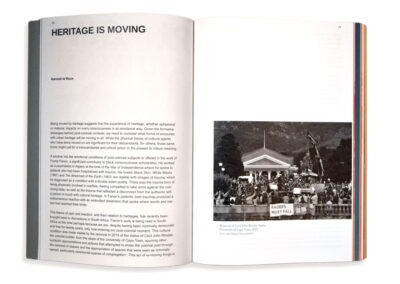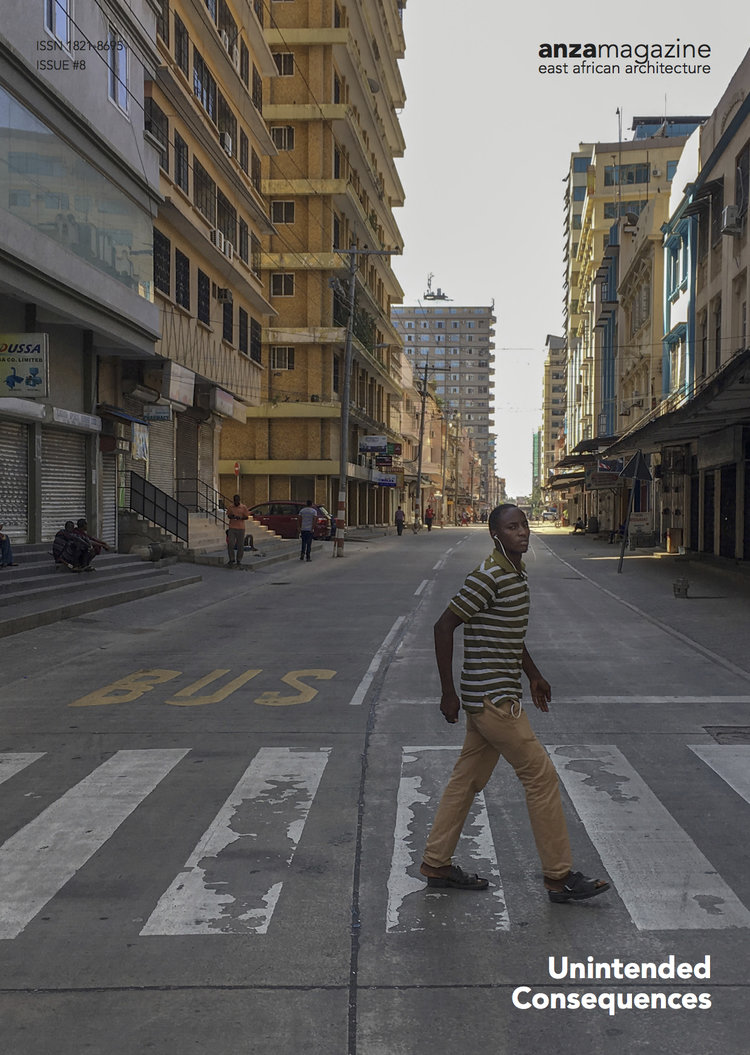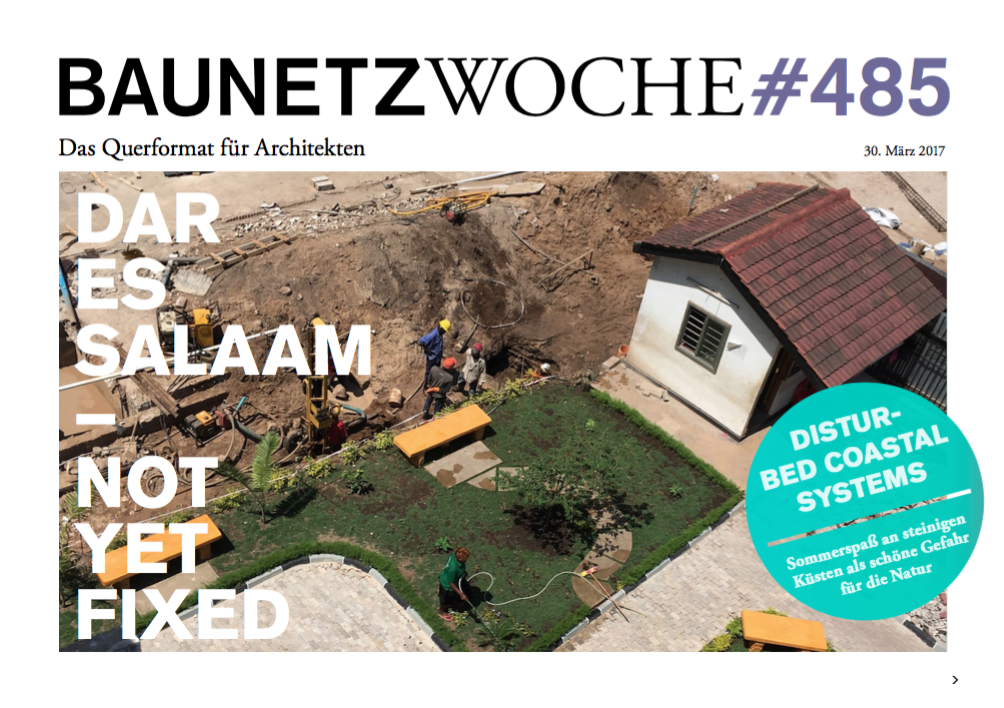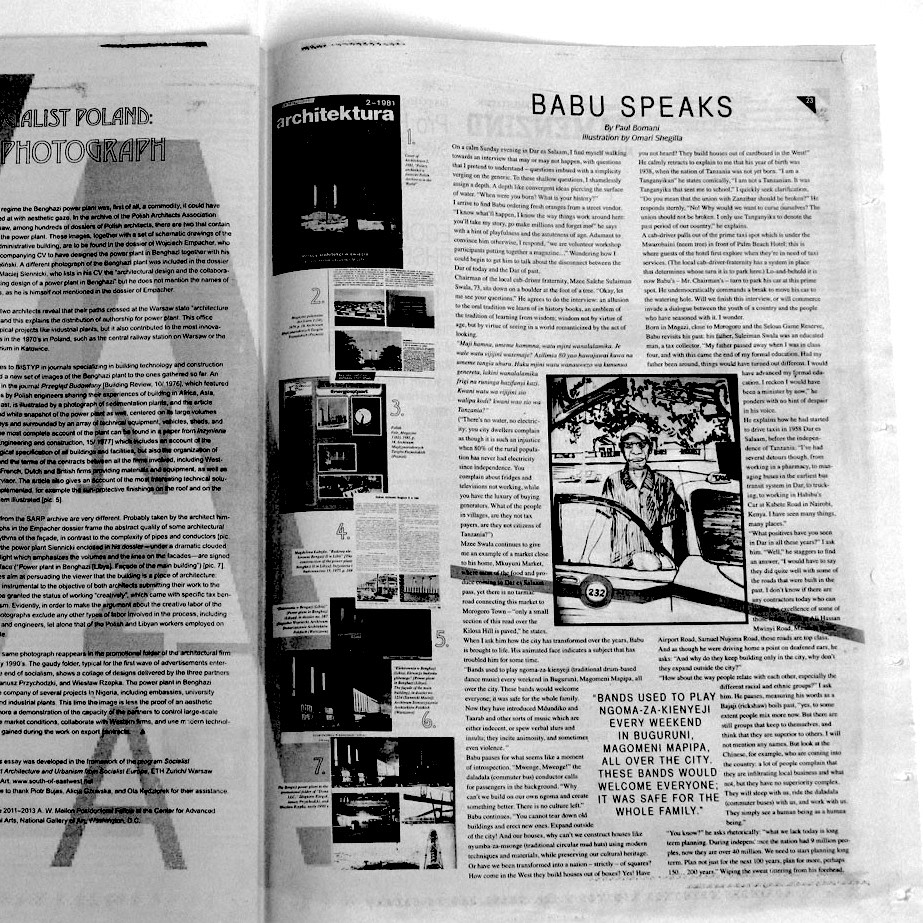
collaborative publications
BERLIN – DAR ES SALAAM
Urban heritage: what is it? Whose is it? Who defines it?
Urithi m’jini: Ni nini? Wa nani? Nani anafafanua?
How to document and communicate heritage?
How to write about the city in a way that leaves room for unheard voices?
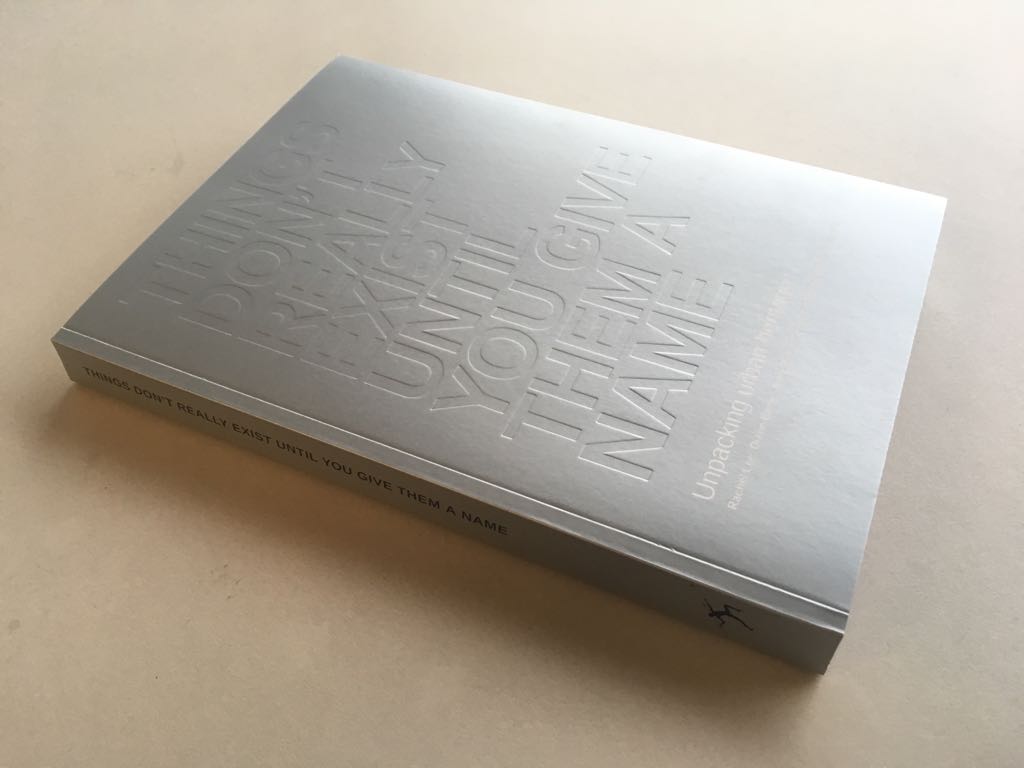
THINGS DON’T REALLY EXIST UNTIL YOU GIVE THEM A NAME: UNPACKING URBAN HERITAGE (2018)
Things don’t really exist until you give them a name traces contemporary urban heritage discourses and practices across the globe. From Dar es Salaam to Berlin, via Istanbul, Flint and Kolkata, a wide range of voices connects to heritage debates. Artists, curators, and activists as well as historians, architects, planners and urban researchers address the urban heritage conundrum: Although heritage is claimed to have the power to achieve social cohesion and galvanise urban communities, it is intrinsically contested and divisive. Through fresh perspectives, concepts, methods and tools rather than a belief in absolute aesthetic and material values, this book argues for a more citizen-centred and rights-based approach to heritage which could help to make cities more just and inclusive.
Edited by Rachel Lee, Diane Barbé, Anne-Katrin Fenk & Philipp Misselwitz
Published with Mkuki na Nyota Dar es Salaam (English version), 2018.
View the table of contents (PDF)
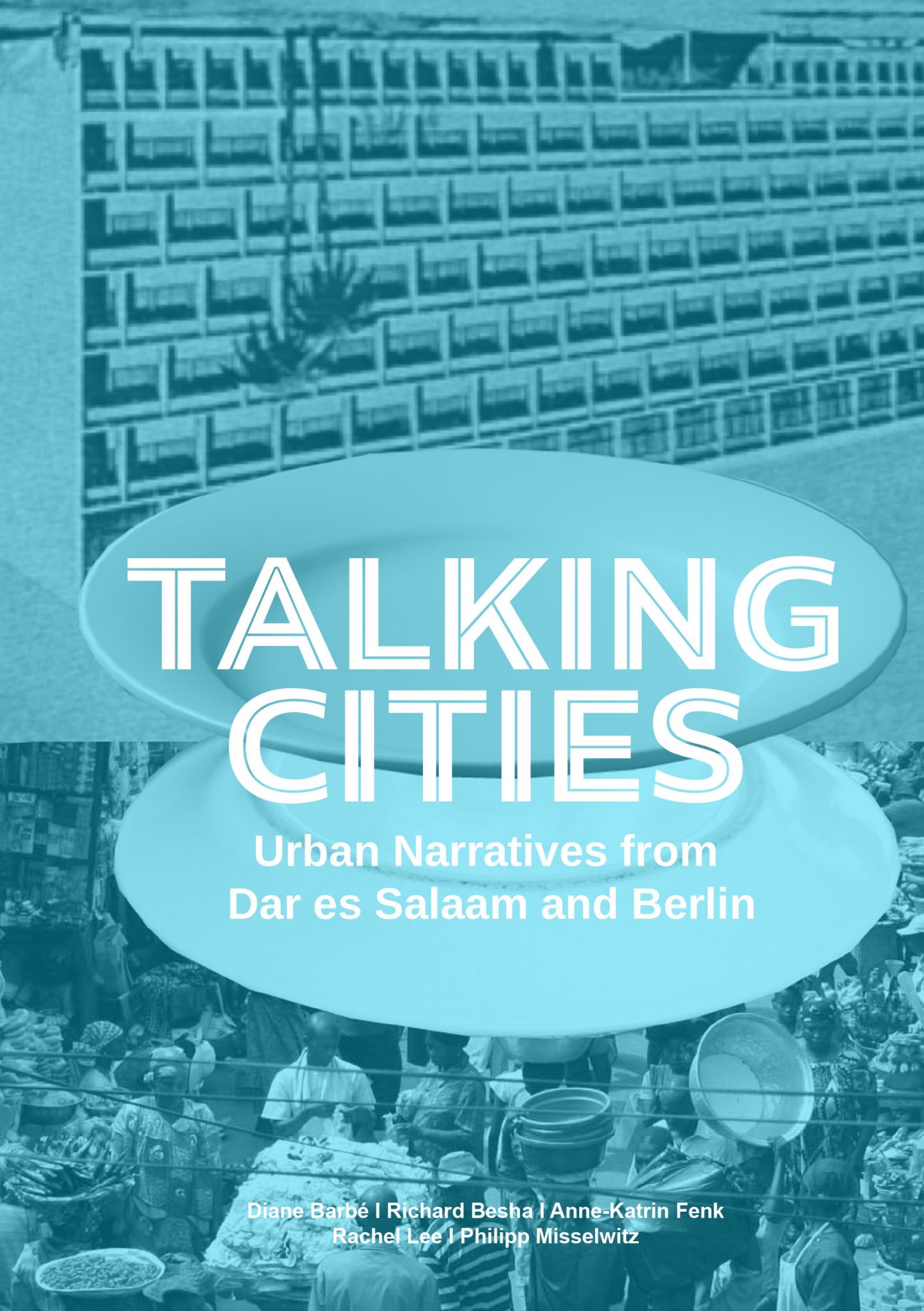
TALKING CITIES: URBAN NARATIVES FROM DAR ES SALAAM & BERLIN (2017)
Where is the link between an immigrant from Lebanon opening a falafel shop in Berlin, and a man who has lived in Dar es Salaam for thirty years, selling maize and snacks next to the bus stop for a living? What connects the anecdote of a woman recalling the wastelands of the Moabit district of Berlin, and a young man describing his memories of childhood games in the sandy fields of Sinza?
This book presents urban narratives from Dar es Salaam, Tanzania, and Berlin, Germnay. Juxtaposing the stories to provoke associations, it explores contradictions and draws parallels between the seemingly dissimilar cities. Based on interviews with local residents in a variety of neighbourhoods in both cities, the stories consider urban heritage ‘from below’. They address the cultural or spatial practices that contribute to a sense of community, the buildings that people identify with, and the places that make a neighbourhood special.
Edited by Diane Barbé, Richard Besha, Anne-Katrin Fenk, Rachel Lee & Philipp Misselwitz
Published with the TU Berlin – Universitätsverlag
Order a copy through the university, read it at the library or download it online as a PDF!
PARTICIPANTS
The texts and photographs collected in this book are the result of an exchange between Ardhi University, Dar es Salaam and TU Berlin. The involved students (and teaching staff) all participated in writing and editing the stories during two summer schools and a research studio. As the process was based on group work and collaboration, no individual authors can be credited. Instead, the book is a work of multi-authorship, created by the following contributors:
Lisa Blum, Iulia Ciomu, Carlo Costabel, Negar Hashemi, Max Hege, Benjamin Herfurth, Sascha Hofmann, MinJi Kim, Darius Duong Le, Sarah Manz, Dorothea Mbosha, Arnold Mkony, Arne Mickerts, Michael Minja, Kate Mrema, Hannes Mundt, Gift Mushi, Ena Ninkovic, Khilan Parmar, Irina Pelmegow, Maryam Poursafar, Andrea Protschky, Franziska Rüss, Aileen Runyoro, Hilbert Shirima, Patrycja Stal, Adrian Taylor, Beatrice Termeer, Arianna Tiberti, Anka Walker, Rui Wang, Pommeline Warringa
UNINTENDED CONSEQUENCES: ANZA MAGAZINE #8 (2017)
The 8th issue of ANZA Magazine, in special collaboration with BaunetzWoche editor Stephan Becker and independent photographer Tassilo Letzel, was published through the Simulizi Mijini project. The two teams worked towards uncovering Unintended Consequences visible in the urban fabric of Dar es Salaam, questioning the impacts of planning and self-construction and the way it has transformed the cityscapes in the 20th century.
An excerpt from the editorial:
“From science, we know that for every action there is an equal but opposite reaction. In other words, there are consequences for everything we do (intended or unintended). Unfortunately, the word consequence has a habit of immediately drawing a negative connotation of the outcome. As the ANZA team, we have seen the various unintended positives outcomes of spaces across East Africa. This is what drew us to the theme; Unintended Consequences.”
What is the Unintended Consequence in your neighbourhood? How is the community affected and dealing with it? Who are the users? Who made/created the original intention or spatial design? Who transforms or reinvents it?
Read more about the issue in this post and on ANZA’s blog. Read the call for contributions.
ANZA Magazine
 ANZA MAGAZINE is an architectural magazine dedicated to exploring people and spaces through in-depth articles, images, scenes and discussions that go beyond the lines that divide building and sky. In the exploration, the team hopes to better understand our transforming East-African cities – and their identities – by looking at past, present, and future with fun, seriousness and humour. In this way, the goal and hope is to shape the planning, engineering, and architecture of East African cities, and add richness to the living spaces.
ANZA MAGAZINE is an architectural magazine dedicated to exploring people and spaces through in-depth articles, images, scenes and discussions that go beyond the lines that divide building and sky. In the exploration, the team hopes to better understand our transforming East-African cities – and their identities – by looking at past, present, and future with fun, seriousness and humour. In this way, the goal and hope is to shape the planning, engineering, and architecture of East African cities, and add richness to the living spaces.
DAR ES SALAAM NOT YET FIXED: BAUNETZWOCHE #485 (2017)
The Dar es Salaam Not Yet Fixed issue of BaunetzWoche focuses on the urban complexities of Dar es Salaam, Tanzania. Editor Stephan Becker and photographer Tassilo Letzel worked in close collaboration with the curatorial team of Simulizi Mijini and the editors at ANZA to put together the key article of this issue of BaunetzWoche, expanding on the theme of Unintended Consequences with was developed in ANZA #8.
Translated from the introduction:
It is a strange contradiction: Everyday life influences our cities, but the official urban heritage does not reveal any such vitality. The rules for evaluating what is preserved as a monument, for example, are too rigid. Unfortunately, the legacy reflects, above all, the knowledge of experts and not necessarily the experiences of people. Would it be possible in future to involve local communities more closely in the decision-making process?
This BaunetzWoche introduces works by some of the artists of the project –Nadin Rescke, KUNSTrePUBLIK and Jan van Esch as well as a review on African-published books on architecture and urban designed written by Comfort Badaru, from ANZA magazine. Get yours for free now!
BAUNETZWOCHE
![]()
BAUNETZWOCHE is a weekly publication, associated with major German publication BauNetz. They will collaborate with ANZA in Dar es Salaam to look at uncanny stories about the city, under the theme ‘Unintended Consequences’.

